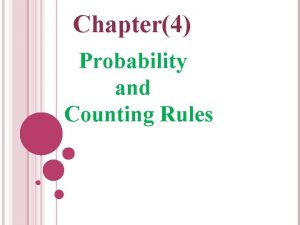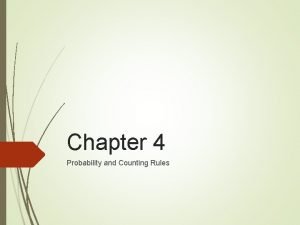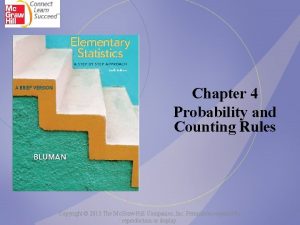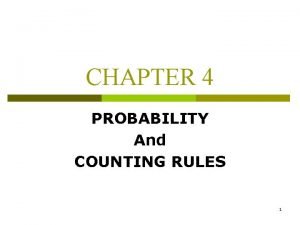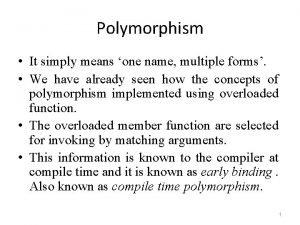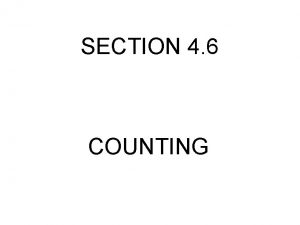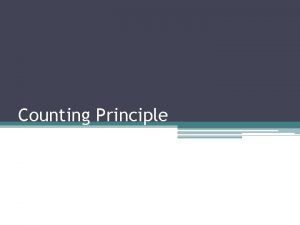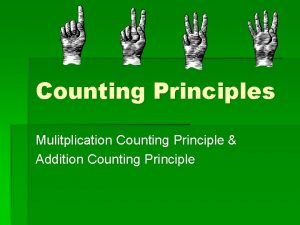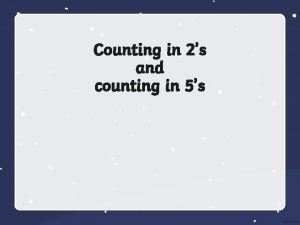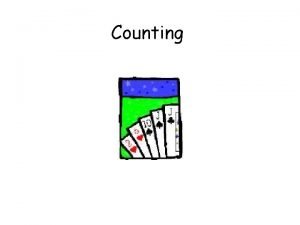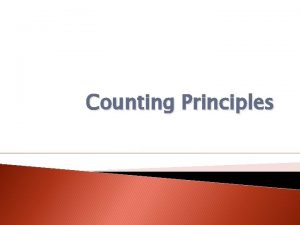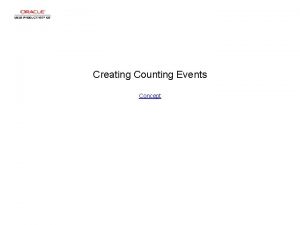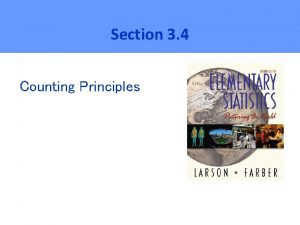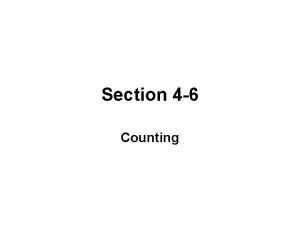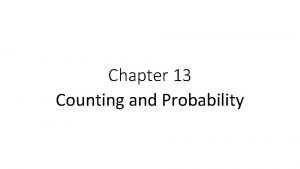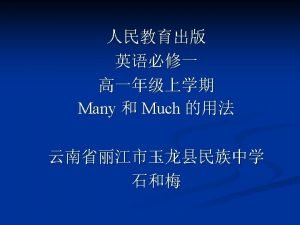Section 4 7 Counting Key Concept In many


















- Slides: 18

Section 4 -7 Counting

Key Concept In many probability problems, the big obstacle is finding the total number of outcomes, and this section presents several methods for finding such numbers without directly listing and counting the possibilities.

Fundamental Counting Rule For a sequence of two events in which the first event can occur m ways and the second event can occur n ways, the events together can occur a total of m ● n ways.

Example 1: It’s wise not to disclose social security numbers, because they are often used by criminals attempting identity theft. Assume that a criminal is found using your social security number and claims that all of the digits were randomly generated. What is the probability of getting your social security number when randomly generating nine digits? Is the criminal’s claim that your number was randomly generated likely to be true? Each of the 9 digits has 10 possible outcomes: 0, 1, 2, …, 9. By applying the fundamental counting rule, we get 10 10 10 = 1, 000, 000 Only one of those 1, 000, 000 possibilities corresponds to your social security number, so the probability of randomly generating a social security number and getting yours is 1/1, 000, 000. It is extremely unlikely that a criminal would generate your social security by chance, assuming that only one social security number is generated.

Example 2: Consider the following questions given on a history test: Arrange the following events in chronological order. a) Boston Tea Party b) Teapot Dome Scandal c) The Civil War The correct answers is a, c, b, but let’s assume that a student makes random guesses. Find the probability that this student chooses the correct chronological order. Although it is easy to list the six possible arrangements, the fundamental counting rule gives us another way to approach the problem. When making the random selections, there are 3 possible choices for the first event, 2 remaining choices for the second event, and only 1 choice for the third event, so the total number of possible arrangements is 3 2 1=6 Because only one of the 6 possible arrangements is correct, the probability of getting the correct chronological order with random guessing is 1/6 or 0. 167.

Notation The factorial symbol ! denotes the product of decreasing positive whole numbers. For example, 4! = 4 ● 3 ● 2 ● 1 = 24. By special definition, 0! = 1.

Factorial Rule A collection of n different items can be arranged in order n! different ways. (This factorial rule reflects the fact that the first item may be selected in n different ways, the second item may be selected in n – 1 ways, and so on. )

Example 3: During the summer, you are planning to visit these 5 Major League Baseball fields: U. S. Cellular Field, Target Field, Comerica Park, Chase Field, and Petco Park. You would like to plan the most efficient route and you decide to list all the possible routes. How many different routes are possible? By applying the factorial rule, we know that 6 different parks can be arranged in order 6! different ways. The number of different routes is 5! = 5 4 3 2 1 = 120. There are 120 different possible routes.

Permutations Rule (when items are all different) Requirements: 1. There are n different items available. (This rule does not apply if some of the items are identical to others. ) 2. We select r of the n items (without replacement). 3. We consider rearrangements of the same items to be different sequences. (The permutation of ABC is different from CBA and is counted separately. ) If the preceding requirements are satisfied, the number of permutations (or sequences) of r items selected from n available items (without replacement) is

Example 4: A manager must select 5 delivery locations from 9 that are available. Find the number of different possible routes by evaluating 9 P 5. 15, 120

Example 5: In horse racing, a bet on an exacta in a race is won by correctly selecting the horses that finish first and second, and you must select those two horses in the correct order. The 132 nd running of the Kentucky Derby had a field of 20 horses. If a bettor randomly selects two of those horses for an exacta bet, what is the probability of winning?

Permutations Rule (when some items are identical to others) Requirements: 1. There are n items available, and some items are identical to others. 2. We select all of the n items (without replacement). 3. We consider rearrangements of distinct items to be different sequences. If the preceding requirements are satisfied, and if there are n 1 alike, n 2 alike, . . . nk alike, the number of permutations (or sequences) of all items selected without replacement is

Example 6: In a preliminary test of the Micro. Sort gender selection method developed by the Genetics and IVF Institute, 14 couples tried to have baby girls. Analysis of the effectiveness of the Micro. Sort method is based on a probability value, which in turn is based on numbers of permutations. Let’s consider this sample problem: How many ways can 11 girls and 3 boys be arranged in sequence? That is, find the number of permutations of 11 girls and 3 boys. We have n = 14 babies, with n 1 = 11 alike (girls) and n 2= 3 other alike (boys). The number of permutations is computed as follows: There are 364 different ways to arrange 11 girls and 3 boys.

Combinations Rule Requirements: 1. There are n different items available. 2. We select r of the n items (without replacement). 3. We consider rearrangements of the same items to be the same. (The combination of ABC is the same as CBA. ) If the preceding requirements are satisfied, the number of combinations of r items selected from n different items is

Example 7: The Virginia Win for Life lottery game requires that you select the correct 6 numbers between 1 and 42. Find the number of possible combinations by evaluating 42 C 6. 5, 245, 786

Permutations versus Combinations When different orderings of the same items are to be counted separately, we have a permutation problem, but when different orderings are not to be counted separately, we have a combination problem.

Example 8: A clinical test on humans of a new drug is normally done in three phases. Phase I is conducted with a relatively small number of healthy volunteers. Let’s assume that we want to treat 8 healthy humans with a new drug, and we have 10 suitable volunteers available. a) If the subjects are selected and treated in sequence, so that the trial is discontinued if anyone displays adverse effects, how many different sequential arrangements are possible if 8 people are selected from the 10 that are available? Because order does count, we want the number of permutations of r = 8 people selected from the n = 10 available people. We get: b) If 8 subjects are selected from the 10 that are available, and the 8 selected subjects are all treated at the same time, how many different treatment groups are possible? Because order does not count, we want the number of combinations of r = 8 people selected from the n = 10 available people. We get:

Example 9: The Florida Lotto game is typical of state lotteries. You must select six different numbers between 1 and 53. You win the jackpot if the same six numbers are drawn in any order. Find the probability of winning the jackpot. Because the order of the selected numbers does not matter, you win if you get the correct combination of six numbers. Because there is only one winning combination, the probability of winning the jackpot is 1 divided by the total number of combinations. With n = 53 numbers available and r = 6 numbers selected, the number of combinations is: With 1 winning combination and 22, 957, 480 different possible combinations, the probability of winning the jackpot is 1/22, 957, 480.
 Minerals concept map
Minerals concept map Lesson 1 introduction to waves
Lesson 1 introduction to waves Chemical symbols and formulas
Chemical symbols and formulas Probability and counting rules examples with solutions
Probability and counting rules examples with solutions Chapter 4 probability and counting rules
Chapter 4 probability and counting rules Chapter 4 probability and counting rules answer key
Chapter 4 probability and counting rules answer key Chapter 4 probability and counting rules answer key
Chapter 4 probability and counting rules answer key Study guide chapter 10 section 1 meiosis
Study guide chapter 10 section 1 meiosis Business model canvasd
Business model canvasd Contoh bisnis model canvas makanan pdf
Contoh bisnis model canvas makanan pdf Real and ideal self concepts
Real and ideal self concepts Pengertian pemasaran
Pengertian pemasaran One name multiple form refers to
One name multiple form refers to Many sellers many buyers
Many sellers many buyers Er diagram in dbms
Er diagram in dbms Convert conceptual model to logical model
Convert conceptual model to logical model Erd vs erm
Erd vs erm Unary many to many
Unary many to many Erd film
Erd film



